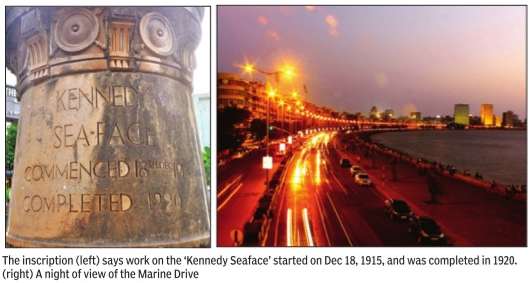Mumbai: M
This is a collection of articles archived for the excellence of their content. |
Marine Drive
The Times of India, Nov 08 2015

Nergish Sunavala
Nearing 100, Marine Drive is still Mumbai's heartthrob
In 1969, two starcrossed lovers left their respective homes in Byculla and booked themselves into a Marine Drive hotel. That night, in a desi version of Romeo and Juliet, the two consumed poison and had to be rushed to St George's Hospital in Fort. The girl survived, the boy didn't. That Marine Drive's glittering boulevard was the backdrop for their last act must have added to the drama perhaps the spot even held sentimental value. After all, lovebirds canoodling along the seafront are as much a fixture here as art deco buildings; and numerous Bollywood flicks have been shot along this iconic stretch.
In December 2015, the Marine Drive promenade turns 100, with a stout lamp post near it announcing the upcoming anniversary in stone. “Kennedy Sea-Face commenced 18th December, 1915,“ it reads. “Completed 1920.“
Though reclamation of the stretch was still decades away , this anniversary marks the creation of a “permanent and powerful“ wall 20ft above beach level extending 4,750ft from Chowpatty to Marine Lines. It replaced a flimsy cribwork, which was con stantly “beaten and broken“ by the heavy monsoon, explains a TOI article dated March 17th, 1916. The report includes a description of the Syke's steam pile driver a machine that held both “novelty“ and “charm“ for passersby and which drove 16ftlong concrete piles with sharp iron points into the ground to create the wall's foundation.
The 1915 project also included a beautification drive as Kennedy sea face's unkempt appearance was considered a “black spot on the reputation of the city“. In order to make the most of Bombay's natural waterfront, an 80ft-wide promenade was planned, which the government hoped to continue along the entire stretch after reclamation. In 2006, the same promenade had to be restored because it was leaking, overrun with hawkers and had fallen into disrepair.
The Backbay reclamation scheme, which envisaged continuing the seafront promenade to Cuffe Parade, was started in 1919. But bad planning, inadequate dredging and corruption allegations led to a truncated stretch of just 16.6 acres. Part of the problem was that the scheme was marketed as a means to decongest poorer sections of the city but the new sea-facing apartment blocks were clearly de signed for wealthier residents. When an enquiry led by lawyer Khurshed Framji Nariman unearthed discrepancies, “the government chose to stop the reclamation,“ explains Commander Mohan Narayan, the former curator of the Maritime History Society . “So, what was reclaimed was from Chowpatty to Sachivalaya and parts of Navy Nagar. Then in the 1960s, they reclaimed two more parcels of land, including Nariman Point and Cuffe Parade,“ he said.
By the 1920s and '30s, the Sir JJ College of Architecture was churning out batches of Indian students, eager to break away from the trappings of the Raj. They began designing Marine Drive's art deco stretch with stucco fronts and curving balconies.Today , this precinct has been nominated as a UNESCO World Heritage Site. After Partition, wealthy Hindu families from Pakistan began relocating to the city and flocked to Marine Drive. Even today, it houses the city's wealthiest residents one former resident and early morning runner recalls constantly hearing people ask each other on the promenade, “Aaje, Reliance nu bhaw su chhe.“
Inevitably , it developed a reputation as the city's most iconic stretch. It was here that actor Amitabh Bachchan spent his first night in the city and actress Suraiya threw Dev Anand's ring into the sea after a soured love affair. For Atul Kumar, who grew up in Mumbai, “it represented Bollywood. It represented the modern India.“